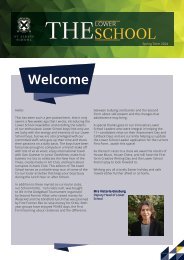You also want an ePaper? Increase the reach of your titles
YUMPU automatically turns print PDFs into web optimized ePapers that Google loves.
46<br />
In Islam, waqf is a donation of one’s<br />
wealth to Allah. Funded by these waqf,<br />
public hospitals treated the sick, provided<br />
Illustration of alshelter<br />
for the elderly and housed the<br />
Mansuri hospital<br />
mentally ill. Part of the state budget<br />
was also used to help maintain the<br />
hospitals. Hospitals were also forbidden<br />
by law to refuse people who were incapable<br />
of paying - thereby creating a free<br />
health service similar to a modern-day<br />
NHS. In some cities, there were even hospitals<br />
set up solely for the purpose of<br />
emergencies - resembling an A&E. <strong>The</strong><br />
first Islamic hospital was built in 805 in<br />
Baghdad by Harun al-Rashid. By the tenth<br />
century, Baghdad contained 5 more hospitals,<br />
Damascus had six hospitals by the<br />
15 th century and Córdoba had 50 major<br />
hospitals. Seen as the best early Islamic<br />
hospitals, the great Syro-Egyptian establishments<br />
of the 12th and 13th centuries<br />
were home to the best known hospital in<br />
the Islamic world - Al-Mansuri Hospital,<br />
built in Cairo by the sultan Qalawun in<br />
1285 – and Aleppo’s Arghun hospital –<br />
known mostly for its treatment of the<br />
mentally ill. Hospitals were divided into<br />
numerous departments; cleaning staff,<br />
pharmacists and universities were also<br />
typically connected directly to hospitals.<br />
Medical students were also allowed to<br />
shadow physicians and participate in patient<br />
care.<br />
<strong>The</strong> Islamic Golden Age also made significant<br />
contributions to the field of pharmacology.<br />
A pharmacist was called saydalani<br />
and introduced new drugs including<br />
sandalwood, camphor, senna, rhubarb,<br />
myrrh, nutmeg, mercury and<br />
coconut. As private pharmacy stores<br />
became more numerous and prominent,<br />
they also became less unregulated.<br />
Decrees by the Caliphs al-<br />
Ma’mun and al-Mutasim required<br />
pharmacists to pass examinations<br />
and hold legal paperwork to allow<br />
them to practice the profession.<br />
Pharmacies were also periodically inspected<br />
by government inspectors,<br />
known as muhtasib. As well as his<br />
Canon of Medicine, Ibn Sian also developed<br />
rules for the testing of drugs<br />
and medication, that are still used in<br />
modern day drug testing.<br />
In conclusion, we can see that the Islamic<br />
Golden Age significantly advanced modern-day<br />
science. <strong>The</strong> innovations of Ibn<br />
Zakariyya al-Razi and Ibn al-Haytham in<br />
experimental observation ensured that future<br />
scientists had a template to allow<br />
them to prove their theories. Ibn al-Haytham<br />
revolutionised the field of optics and<br />
his theory allowed other scientists to make<br />
significant advancements in optics. Books<br />
written by Islamic scholars in the Islamic<br />
Golden Age, such as Canon by Ibn Sina<br />
and Kitab al-Tasrif by al-Zahrawi, provided<br />
a source of medical information for<br />
European doctors and surgeons. <strong>The</strong> Islamic<br />
improvements of hospitals and<br />
pharmacies created a foundation to allow<br />
other scientists to develop more efficient<br />
and hygienic facilities. However, all these<br />
advances would not have been possible<br />
unless the early Abbasid caliphs had use<br />
teachings from Prophet Muhammad<br />
ﷺ and the Quran promoting knowledge – in<br />
particularly science – as motivation for<br />
their actions.<br />
Taha, 4.4


















